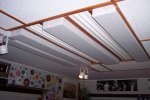Nola
Well-known member

Nothing wrong with doing proper things to get your studio "perfect"...but man, I do feel that people get too worked up over it.
I mean, get some basic trapping, tweak a few things, and then....learn how to work in your space.
That's how I feel about it, too, but I just want to get rid of the flutter echo b/c it sounds really bad. I don't want to go down a rabbit hole tho.
What's the best way to figure out what the problem frequencies are? Like just put a mic and look at a spectrum graph while playing? I had to EQ out like 1k-2k range b/c the flutter was developing an actual pitch in there, so is that the problem range, and if so, would foam fix that? I read something online about placing foam where a mirror hits the first reflection but wasn't really sure. I'm not a pro studio and never will be so like i just need to tame this flutter and then i'd be content.



